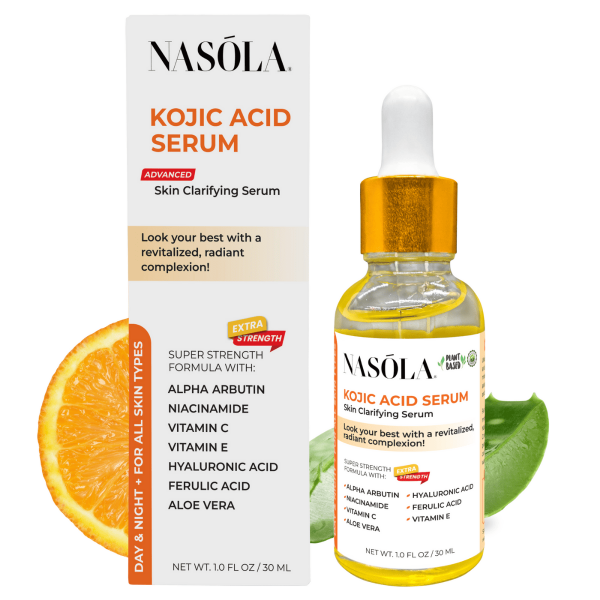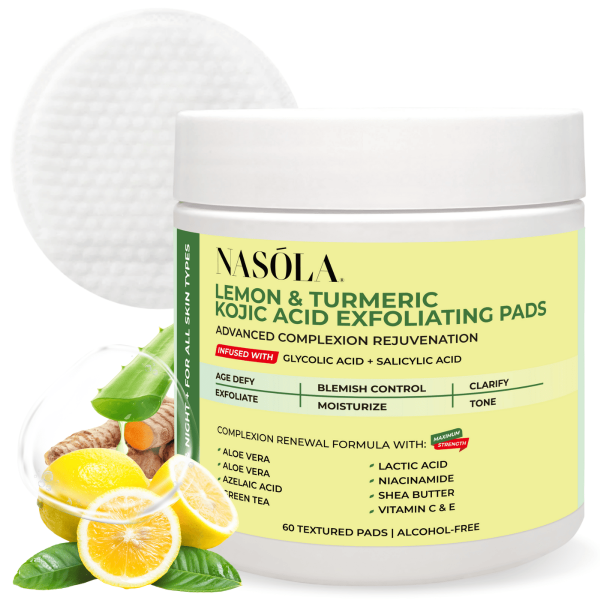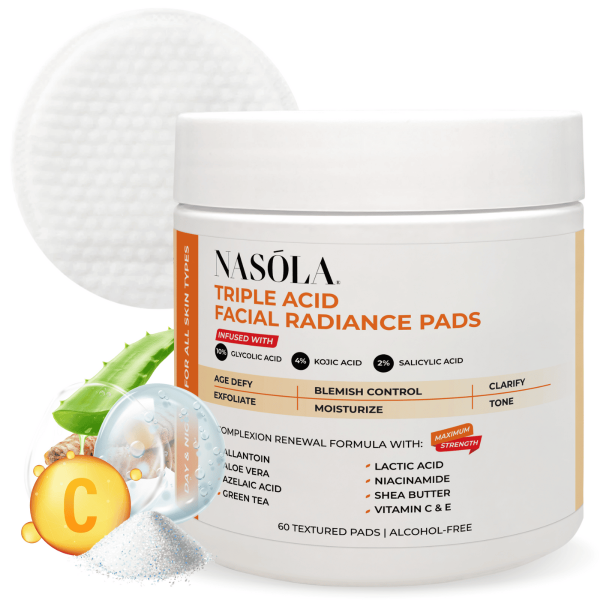If you’ve been staring a little too long at that one stubborn dark spot… you’re not alone. Salicylic acid for hyperpigmentation isn’t just a buzzword—it’s a powerhouse solution many of us overlook after trying product after product with high hopes and low results.
Hyperpigmentation, those patches of skin that decided they’d keep the sun’s memory longer than others, is incredibly common. Caused by acne, sun damage, or inflammation—these marks can hang out longer than we want them to.
But… what if your skincare routine had a twist? One ingredient. Multiple benefits. Serious glow-up?
Today, we’re spotlighting solutions like the Nasola Triple Acid Facial Radiance Pads, Lemon Turmeric Kojic Acid Exfoliating Pads, Kojic Acid Serum, and Kojic Acid Facial Toner—each crafted with active ingredients designed to minimize discoloration and even out your complexion beautifully.
Let’s get right into it.
- How Salicylic Acid for Hyperpigmentation Works
- The Science Behind Salicylic Acid Hyperpigmentation Treatments
- Ingredient Focus: Lemon Turmeric and Kojic Acid for Enhanced Skin Brightening
- Using Kojic Acid with Salicylic Acid for Hyperpigmentation
- The Role of Facial Toners in Treating Hyperpigmentation
- Additional Skincare Tips When Using Salicylic Acid for Hyperpigmentation
- Frequently Asked Questions
How Salicylic Acid for Hyperpigmentation Works

Hyperpigmentation owes much of its persistence to dead skin buildup and disrupted skin cell turnover. Salicylic acid hyperpigmentation treatments tackle both—right at the root.
Let’s unpack the how and why behind this ingredient’s magic, then take a look at what happens when it’s paired with the right allies in skincare.
What is Salicylic Acid?
At its core, salicylic acid is a beta hydroxy acid (BHA). Unlike AHAs like glycolic or lactic acid, salicylic acid is oil-soluble—which means it doesn’t just sit on the skin’s surface.
It dives deep.
This molecule penetrates clogged pores, dissolves the oil that traps dead skin and bacteria, and gently encourages your skin to shed its outermost layer.
This process, known as chemical exfoliation, leaves skin smoother, clearer, and more balanced. For those with oily or acne-prone skin, salicylic acid is often the go-to… but for hyperpigmentation, it does even more:
- Deep pore action clears out debris and reduces dark marks caused by breakouts.
- Speeds up skin cell turnover so discolored cells shed faster.
- Gently resurfaces skin for smoother texture and clarity.
- Evens out skin tone over time with consistent use.
This makes salicylic acid for hyperpigmentation a dual-agent: preventing and treating, all in one.
Why Salicylic Acid is Effective for Hyperpigmentation
So—why salicylic acid? Simple. It’s slow but consistent.
Once applied, it starts to tweak the rhythm of your skin renewal cycle. Instead of lingering pigment in the uppermost layers, those cells start turning over faster and cleaner.
Because of its oil-solubility, salicylic acid sneaks into even the smallest blocked pores—clearing out not just acne, but hyperpigmented remnants.
Now add it to a trio of actives and you’ve got something special…
Recommended Product: Nasola Triple Acid Facial Radiance Pads
Meet your multi-action skin reset: Nasola Triple Acid Facial Radiance Pads.
These exfoliating pads harness the combined power of:
- Salicylic Acid – Targets inflammation and exfoliates deep inside pores.
- Glycolic Acid – Speeds up surface-level skin renewal.
- Lactic Acid – Deeply hydrates and softens while gently sloughing off dull skin.
It’s your anti-hyperpigmentation powerhouse in swipe-and-go form. These pads visibly brighten dull skin and fight discoloration at multiple levels—leaving fresh, rejuvenated skin.
Use them 2–4 times weekly to build glow without irritation.
The Science Behind Salicylic Acid Hyperpigmentation Treatments
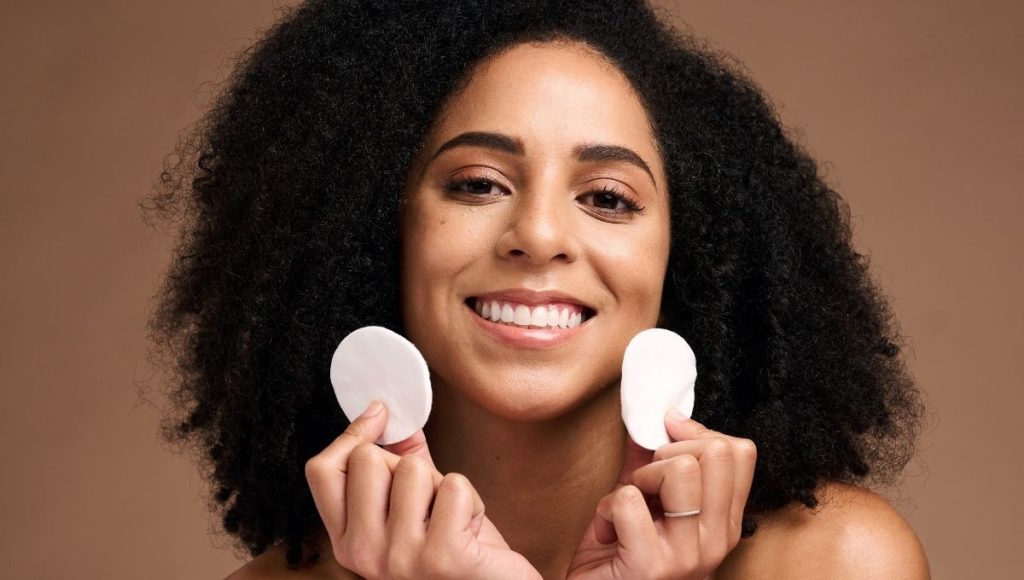
Science isn’t here to be boring. It’s here to back up the glow.
Salicylic acid hyperpigmentation treatments work on a few levels—from cellular renewal to pigment removal. Understanding how BHAs work gives you control. And when paired with other acids, the results multiply. This is where clarity meets intention.
The Role of BHA in Skin Tone Correction
Salicylic acid is all about uncovering what’s fresh underneath what’s overstayed its welcome.
It breaks the “glue” that holds dead skin cells together and nudges your skin to replace itself faster. With consistent use, this helps fade the look of:
- Post-acne marks
- Sunspots
- Melasma
- Uneven patches from inflammation
Your skin begins to look more uniform, and honestly… more alive. And who doesn’t love seeing that “wow, your skin looks amazing!” selfie filter IRL?
Consistency. Patience. A little glow magic every day.
Synergy with Other Ingredients
Want to make salicylic acid for hyperpigmentation work harder? Team it up with alpha hydroxy acids (AHAs).
- Glycolic Acid – An AHA that exfoliates the surface layers to improve tone + texture.
- Lactic Acid – A gentler AHA, known for giving skin a moisture bounce while exfoliating.
Together with salicylic acid, they speed up brightness, fade stubborn spots, and refine skin texture.
Why not take the stress out of mixing and blending acids and just grab Nasola Triple Acid Facial Radiance Pads? It’s like salad, soup, and dessert served up in one pad.
Ingredient Focus: Lemon Turmeric and Kojic Acid for Enhanced Skin Brightening

Now, let’s talk nature’s helpers: the brighteners that have been around before any of us knew what “melanin synthesis” even meant.
Combining ancient remedies like turmeric with modern science leads to visible, reliable results—especially when brightening hyperpigmentation naturally and gently.
Lemon Turmeric — Ancient Remedies Meet Modern Skincare
Turmeric has been treasured in South Asian beauty rituals for centuries. And for good reason.
It contains curcumin—a natural compound with antioxidant and anti-inflammatory benefits. When used consistently topically, it fades stubborn pigment and fights oxidative damage before it can turn into dark spots.
Lemon extract? That’s Mother Nature’s Vitamin C punch-in-the-face—for dullness, that is.
So what do they do together?
- Reduce oxidative stress that causes spots to reoccur.
- Balance skin tone by suppressing excess melanin.
- Boost glow without causing irritation.
- Brighten pigmentation gradually over time.
Basically? Skin clarity… the botanical way.
Ideal Product: Nasola Lemon Turmeric Kojic Acid Exfoliating Pads
Imagine bright skin sealed in a jar. Nasola Lemon Turmeric Kojic Acid Exfoliating Pads give you that.
Powered by:
- Kojic Acid – Natural melanin-blocking compound distilled from fungi.
- Salicylic Acid – Keeps pores clear and skin layers turning over.
- Lemon + Turmeric Extracts – Brighten, calm, and act as antioxidants.
Swipe 2–3 times a week to begin. You’ll start seeing fresher, smoother skin with fewer dark patches and more… well, confidence.
Use these pads as a replacement or on rotation with the triple acid pads to avoid over-exfoliation.
Using Kojic Acid with Salicylic Acid for Hyperpigmentation

Kojic acid isn’t just a feature—it’s the co-star.
By targeting melanin on a chemical level and blocking tyrosinase (the enzyme responsible for pigment), kojic acid slows down dark spot formation before it starts. Pair it with an exfoliator and BAM!—out with the old, in with the flawless.
What is Kojic Acid and How Does it Complement Salicylic Acid?
Together, salicylic acid and kojic acid are pretty much the cleanup crew and the bouncer.
- Salicylic acid uncovers fresh skin.
- Kojic acid blocks new pigment from forming.
Every time you exfoliate with a BHA, the skin is prepped—clean slate. Applying kojic acid right after means fewer chances for pigment reformation.
This is why most effective skincare systems treat AND prevent hyperpigmentation simultaneously.
Recommended Product: Nasola Kojic Acid Serum
Here comes the serum you didn’t know you needed: the Nasola Kojic Acid Serum.
This is:
- Lightweight.
- Fast-absorbing.
- Hyper-focused on discoloration.
Apply it after exfoliation for:
- Reduction in sun damage and melasma.
- Suppression of future hyperpigmentation.
- Boost in skin tone uniformity and clarity.
Best part? It plays well with nearly every exfoliant and hydrator. If you’re looking for an anti-dark spot serum with clear results—this is your ally.
The Role of Facial Toners in Treating Hyperpigmentation
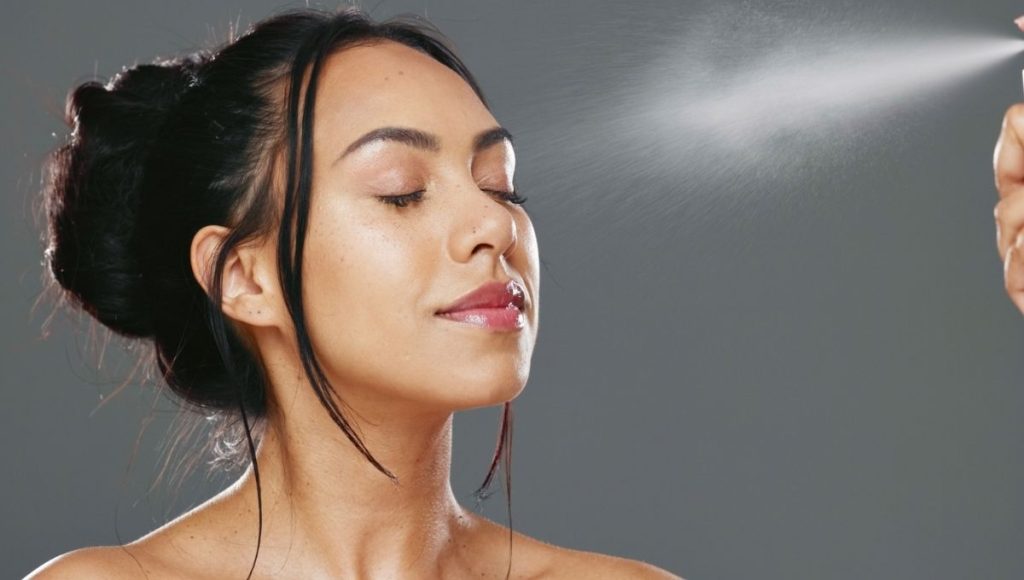
Ironically, toners are often skipped—but they’re the skin whisperers.
Post-exfoliation, your skin is in a vulnerable, absorbent state. A good toner reduces irritation, resets the skin’s pH, and enhances product penetration.
Do it right and pigmentation goes down. Skip it… and you may send your skin into chaos.
Why Toner is Essential Post-Exfoliation
Here’s why you need a toner—especially after salicylic acid:
- Balancing act – Resets acidity after exfoliation.
- Hydration kickstart – Preps your skin to drink up moisturizers.
- Soothing – Reduces risk of inflammation and redness post-treatment.
- Absorption booster – Helps the cleaner skin layers intake serums more effectively.
Don’t sleep on toner—it’s more than watery fluff.
Best Pick: Nasola Kojic Acid Facial Toner
Say hello to glow control. The Nasola Kojic Acid Facial Toner is your go-to prep step after exfoliation.
Infused with:
- Kojic Acid to prevent new spots.
- Brightening botanicals to enhance tone.
- Calming agents to comfort skin post-BHA.
A few swipes with this toner and your skin is ready for whatever nourishing serum or cream you’re applying next.
Or maybe even ready to skip makeup altogether… 😏
Additional Skincare Tips When Using Salicylic Acid for Hyperpigmentation

Using salicylic acid for hyperpigmentation is a game-changer—but like any potent skincare ingredient, it demands respect.
Start slow, listen to your skin, and make smart pairing decisions to reap those brightening benefits without the setbacks.
Start Slowly and Monitor Skin Response
Don’t assume your skin’s ready to go daily right away.
Best practices:
- Begin use 2–3 times per week.
- Watch for dryness, peeling, or stinging.
- Alternate exfoliants to avoid irritation.
- Adjust frequency based on tolerance over time.
Your skin barrier is your BFF—don’t bully it.
Always Wear Sunscreen
Yes, always. Especially now.
Salicylic acid makes your skin more sensitive to UV exposure.
So:
- Use SPF 30 or higher (broad spectrum is best).
- Reapply if you’re exposed to sunlight.
- Protect your progress (or risk setting it back).
- Consider a hat or umbrella if dealing with intense pigmentation.
Pair with Hydrating Ingredients
Exfoliation without hydration? Big no.
After using any chemical exfoliant:
- Layer hydrating serums with hyaluronic acid.
- Use moisturizers with niacinamide for skin barrier repair.
- Apply creams rich in ceramides to lock in moisture.
- Avoid combining with actives like retinol unless advised.
Nourishment is key to maintenance.
Frequently Asked Questions
The Nasola Triple Acid Facial Radiance Pads are a strong contender. With salicylic acid, glycolic acid, and lactic acid—these pads exfoliate deeply, brighten skin, and target uneven tone effectively.
Absolutely! Kojic acid and salicylic acid make a powerful duo. Kojic acid targets pigment production while salicylic acid speeds up skin turnover. Try Nasola Lemon Turmeric Kojic Acid Exfoliating Pads for both in one.
It typically takes 4–6 weeks with regular use. Depending on skin type and severity, some users may see improvement sooner. Consistency and sun protection are key.
Yes! A toner like the Nasola Kojic Acid Facial Toner helps calm the skin after exfoliation and prepares it to absorb serums more effectively.
Use a kojic acid-based serum like the Nasola Kojic Acid Serum. It works well post-exfoliation and helps fade melasma, sun spots, and post-acne marks.
Daily exfoliation may be too harsh, especially for beginners. 2–4 times weekly is sufficient for most. Watch your skin’s reaction and adjust frequency accordingly.
Yes, every single day. Salicylic acid increases your skin’s sensitivity to the sun. Not using sunscreen can reverse progress and worsen spots.
Yes! Many men benefit from salicylic acid to clear out acne scars and pigmentation. It’s great for oily or acne-prone skin and fits easily into a basic routine.
Common side effects include dryness, peeling, and slight stinging. If irritation persists, reduce application frequency and buffer with moisturizing products.
Avoid using salicylic acid with retinol or benzoyl peroxide at the same time. This can overly dry or irritate the skin unless approved by a skincare professional.


